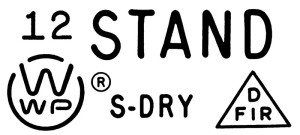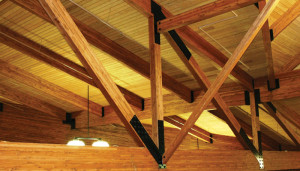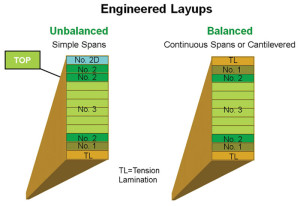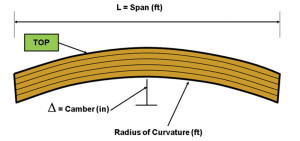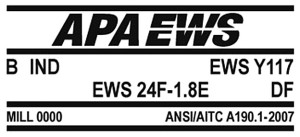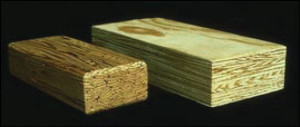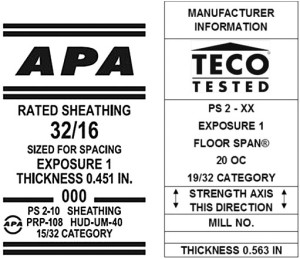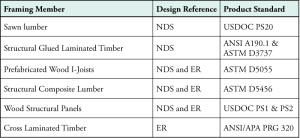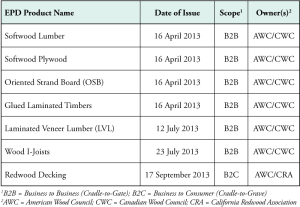Wood frame construction utilizing traditional and engineered wood products is the predominant method of building homes and apartments in the United States. Increasingly, wood framing is also being used in commercial and industrial buildings due to its economy and architectural flexibility. Wood frame buildings are economical to build in a wide range of climate zones. Wood framing is readily available and adaptable to traditional, contemporary and the most futuristic building styles. History has demonstrated the inherent strength and durability of wood frame buildings. The purpose of this article is to summarize the various traditional and engineered wood products that are available throughout North America, and to provide information on how designers can use wood products to build structures that are both sustainable and efficient. It should be noted that, although the authors tried to provide practical information regarding typical structural sizes, designers should verify with local suppliers regarding availability.
Solid Sawn Lumber is a manufactured product derived from a log through sawing and surfacing. Structural and framing lumber is readily available in rafters, joists and studs from 2×4 to 2×12 and sometimes 2×14 nominal. Heavy timbers for beams and columns of 4x, 6x, 8x and even up to 20x are available for Western species such as Douglas Fir. With Southern Pine, 2x size is typical and can be used to create built up beams of 2 to 3 members for headers, and beams with 6×6 size for columns. Standard lengths are 8 to 20 feet in two-foot increments, although some suppliers may have longer lengths.
Engineered designs that compute the required sizes of members are based on the standard dressed sizes and not the nominal sizes. All solid sawn lumber used for load-bearing purposes, including end-jointed structural lumber, are identified by a grade mark of a lumber grading/inspection agency accredited by the American Lumber Standards Committee according to the Softwood Lumber Standard PS20.
Structural lumber is either visually or mechanically graded on the basis of its strength; each grade combination has an assigned design value. Mechanically graded lumber is typically used for pre-engineered framing systems such as roof and floor trusses. General classifications include: dimensional lumber (2x, 3x and 4x) grades and timber grades or classifications known as “Dimension,” “Beams and Stringers,” “Posts and Timbers,” and “Decking,” with design values assigned to each grade. Standard grades for each product class should be specified after considering all grades appropriate for the intended use and strength requirements. For structural applications, include the required reference design values along with the grade that represents those design values. Also, specify desired moisture content (percent) such as GREEN or DRY based on requirements for the product, grade and intended use.
Glued Laminated Timber (glulam) is made up of wood laminations, or “lams,” that are bonded together with adhesives. The grain of all laminations runs parallel with the length of the member. Individual lams typically are 1-3/8 inches thick for Southern Pine and 1½ inches thick for Western species, although other thicknesses may also be used. Glulam is available in both stock and custom sizes. Stock beams are manufactured in commonly used dimensions and widths cut to length when the beam is ordered from a distributor or dealer. Typical stock beam widths used in residential construction include 3-1/8, 3½, 5-1/8, 5½ and 6¾ inches. For non-residential applications, where long spans, unusually heavy loads, or other circumstances control design, custom members are typically specified. Common custom shapes include straight beams, curved beams, pitched and curved beams, radial arches and tudor arches. Members can be manufactured to any length, but transportation constraints must be considered for longer members.
Glulam may be manufactured as unbalanced or balanced layups. In unbalanced beams, the quality of lumber used on the tension side of the beam is higher than the lumber used on the corresponding compression side, allowing a more efficient use of timber resources. Balanced members are symmetrical in lumber quality about the mid-height of the beam.
Glulam is available in a range of different appearances, but having the same structural characteristics for given strength grades. Glulam appearance classifications are: Framing, Industrial, Architectural (stock beams are often supplied with this appearance so they may be exposed to view in the finished structure) and Premium (available only as a custom order where finish appearance is of primary importance).
Camber is a curvature built into a fabricated member which opposes the direction and magnitude of the calculated deflection that occurs under gravity loads. The glulam industry recommends the camber for roof beams be 1½ times the calculated dead load deflection and for floor beams 1.0 times the calculated dead load. Camber is specified as either “inches of camber” or as a radius of curvature. Stock beams are typically supplied with a relatively flat camber radius of 3500 feet or zero camber.
Glulams need to be manufactured and identified as required in ANSI/AITC A190.1 Structural Glued Laminated Timber and ASTM D 3737. Glulam beams will have a trademark that signifies it was manufactured in conformance with these provisions. The trademark may also include: structural use, mill number, structural grade designation, and appearance grade.
Prefabricated Wood I-Joists are “I” shaped engineered wood structural members that are prefabricated using sawn or structural composite lumber flanges and OSB or plywood webs, bonded together with exterior type adhesives. Typical I-joists for residential use are available in 9½, 11-7/8, 14 and 16-inch depths. For I-joists over 22 inches in depth, the design should consider the possible requirement of sprinklers in concealed spaces. Most manufacturers supply I-joists to distributors in lengths up to 60 feet. These are frequently cut to lengths of 16 to 36 feet. Typical applications are as rafters or joists. Similar to lumber, these framing members can be cut to any length on the jobsite to meet various framing challenges.
Assemblies using prefabricated wood I-joists need to meet the provisions of ASTM D5055 Standard Specification for Establishing and Monitoring Structural Capacities of Prefabricated Wood I-Joists, the governing building code, and any additional requirements as set forth in the manufacturer’s code evaluation report. I-joists need to be identified with the manufacturer’s name and the quality assurance agency’s name.
Structural Composite Lumber is a family of engineered wood products created by layering dried and graded wood veneers or strands with moisture resistant adhesive into blocks of material known as billets, which are subsequently resawn into specified sizes. Common types of SCL include laminated veneer lumber (LVL) and parallel strand lumber (PSL).
LVL is produced by bonding thin wood veneers, with the grain of the veneers parallel to the long direction. LVLs are available in 1¾-inch widths x 5½- to 24-inch depths and up to 60-foot lengths. Up to 4 LVLs may be connected together to create a larger beam or header.
PSL is manufactured from veneer clipped into long strands laid in a parallel formation and are typically used as beams, headers and columns. PSLs are available in 3½- to 7-inch widths x 9¼- to 18-inch depths, and up to 60 foot lengths. Custom depths, achieved through secondary lamination, are available up to 54 inches. Similar to LVL, 2 to 3 PSLs can be connected together to create a larger beam.
Single members or assemblies using structural composite lumber (SCL) need to meet the provisions of ASTM D5456 Standard Specification for Evaluation of Structural Composite Lumber Products and any additional requirements as set forth by governing building codes. SCL needs to be identified with the manufacturer’s name and the quality assurance agency’s name.
Wood Structural Panels are wood-based panel products bonded with a waterproof adhesive. Included under this designation are plywood and oriented strand board (OSB).
Wall and roof sheathing are manufactured in 3/8, 7/16, 15/32, ½, 19/32, 5/8, 23/32, and ¾-inch thicknesses, and floor sheathing is typically 19/32, 5/8, 23/32, ¾, 1, and 1-1/8-inch thick.
Plywood is a wood structural panel comprised of plies of wood veneer arranged in cross-aligned layers and bonded with an adhesive that cures on application of heat and pressure. Most plywood manufacturers produce 4- x 8-foot panels. A few western mills have lathes and presses that can produce panels of 4 x 10, 5 x 10, 4 x 12 and 5 x 12 feet and even fewer that produce 10- and 12-foot panels. Larger panels can be produced by joining two panels together with structural scarf or finger joints.
Oriented strand board (OSB) is a wood structural panel comprised of thin rectangular wood strands arranged in cross-aligned layers with surface layers, normally arranged in the long panel direction, and bonded with waterproof adhesive. OSB panels are typically 4 x 8 feet in size. Because OSB is typically manufactured in large sizes, many manufacturers can custom-make panels in almost any size by simply altering the cutting pattern. Most OSB manufacturers make oversized panels up to 8 x 24 feet, which are typically used for panelized roof systems or modular floors.
Both panels are produced in two bond classifications – Exterior and Exposure 1. Exterior panels have bonds capable of withstanding repeated wetting and drying cycles or long-term exposure to weather or other conditions of similar severity. Exposure 1 panels are suitable for uses not involving long-term exposure to weather. Panels classified as Exposure 1 are intended to resist the effects of moisture due to construction delays, or other conditions of similar severity.
The panels need to meet the provisions of U.S. Department of Commerce Voluntary Product Standard 1 (PS1) Structural Plywood, U.S. Department of Commerce Voluntary Product Standard 2 (PS2) Performance Standard for Wood-Based Structural-Use Panels, or applicable code evaluation reports. Each panel will need to be identified for grade, bond classification, and Performance Category by the trademarks of an approved testing and grading agency.
Cross-laminated Timber (CLT) is a prefabricated engineered wood product consisting of at least three layers of solid-sawn lumber or structural composite lumber where the adjacent layers are cross-oriented and bonded with structural adhesive to form a solid wood element. CLT is a flexible building system suitable for use in all assembly types (e.g., walls, floors and roofs). Panels are prefabricated based on the project design requirements and arrive at the job site with windows and doors pre-cut. Although size varies by manufacturer, they can be as large as 54.1 x 9.7 x 1.6 feet and include 3, 5, 7, or more layers. Cross-laminated timbers are manufactured and identified as required in ANSI/APA PRG 320-2011 including the manufacturer’s name and the quality assurance agency’s name.
Table 1 shows which framing member types are covered in the National Design Specification® (NDS®) for Wood Construction in addition to those covered by national evaluation reports (NER) – also called evaluation service reports. Evaluation reports are developed for proprietary products and provide designers and code officials with the appropriate information to design the framing member per the NDS.
Design values for sawn lumber and glulam can be found in the NDS Supplement: Design Values for Wood Construction. Design values for wood I-joists and SCL are provided by the product’s manufacturer. Wood structural panel design data is provided in the NDS, and capacities for shear walls and diaphragms using WSPs is provided in the Special Design Provisions for Wind and Seismic (SDPWS). Design capacities for CLT are provided by the manufacturer.
Environmental Product Declarations
As sustainable construction continues to become more mainstream, wood is poised to help engineers design structures that are safe and sustainable. In 2013, American Wood Council (AWC) released a series of Environmental Product Declarations (EPDs) for multiple wood products. EPDs are considered a type of environmental label or “ecolabel” – a document that gives information regarding the environmental characteristics of a product. ISO has developed standards on ecolabels that place them into three broad categories:
- Type I – governed by ISO standard 14024. Awarded by third party programs to products demonstrating good environmental attributes.
- Type II – governed by ISO standard 14021. Based on self-declared claims by manufacturers about some aspect of their product. An example is a manufacturer’s “green” label on their biodegradable product.
- Type III – governed by ISO standard 14025. These ecolabels are commonly referred to as EPDs.
The data reported in a typical EPD is collected using Life Cycle Assessment (LCA) techniques. LCA is a scientific, internationally-accepted technique for assessing potential environmental impacts associated with some or all stages of a product’s life. Results of LCA studies are sensitive to system boundaries; different boundaries can give different results for the same product. Generic EPDs for the following structural products have been developed:
- Softwood Lumber
- Softwood Plywood
- OSB
- Glulam
- I-joists
- LVL
With the exception of redwood decking, all EPDs shown in Table 2 are “cradle-to-gate,” beginning with life-cycle assessment of the resource, tracking product flows through the manufacturing process, and ending at the manufacturer’s exit gate, ready for shipment. It is noted that this limits the ability to account for the benefit of carbon sequestration by offsetting the release of biogenic CO2. This accounting is an accepted practice in cradle-to-grave LCA reports, since it is not realized at the point of manufacturing, but rather occurs over the life cycle of the product. These EPDs are compliant with ISO 14025 – Type III Environmental Product Declaration, and can be used to earn points in both the LEED and Green Globes building certification systems. For more information and to download the free EPDs.▪

